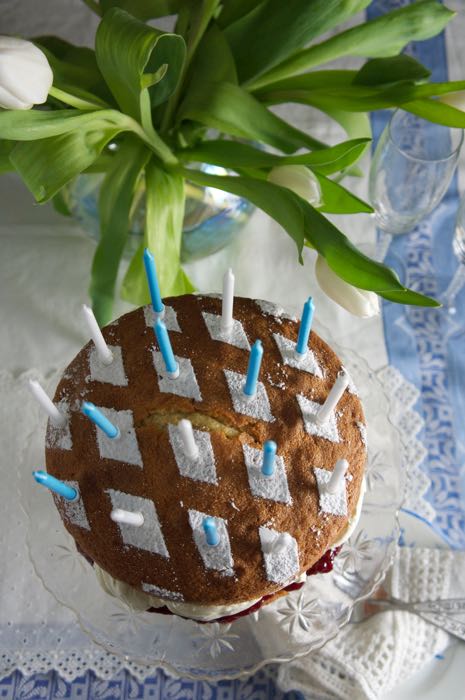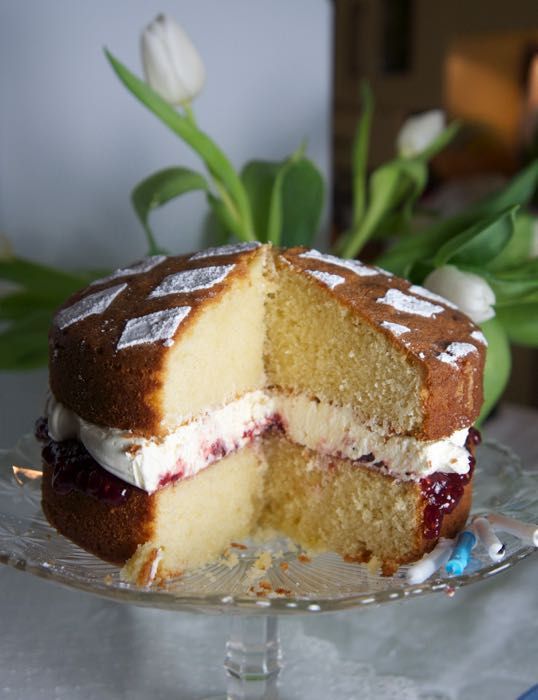Of all the cakes in the all the world this is the one that no one ever seems to say ‘Oh, none for me thank you’ to.
It is still my husband’s favourite cake of all time, coming top of the cake hit parade after years of trying to seduce him with pattisseries, parfaits and panfortes, he still always requests a Victoria Sandwich for his birthday and it is usually his cake of choice when we pop into a tea room or cafe for a cup of tea and slice of something nice.
The cake in the photographs is the one I made for his birthday this year. And we did make him blow out the candles, he limply protested but I could see in his face he quite liked the fact he was being spoilt as much as a ten year old. And why not, we all like a bit of fuss made of us every now and then and if putting a few candles on a middle-aged man’s birthday cake makes him grin like a cheshire cat then its worth the extra £1.00.
Probably the first ‘big’ cake made by all school girls, comprised of the easiest ingredients list, easy to remember and, hopefully, usually fail safe, the cake still manages to generate heated debates and risen eyebrows of disapproval at local cakes sales across the land. Too flat, too raised. Overcooked, too pale. Too airy, too hard. I suppose it’s a bit like a bob haircut, sublime simplicity to look at but very easy to get wrong.
If it does go wrong there are usually a few reasons why. I remember once when I was at school getting very upset that my sponge hadn’t risen. After spending the rest of the lesson insisting that I had followed the recipe to the letter, it wasn’t until I got home that I realised I had taken plain flour to school instead of self-raising.
Opening the door under half way through cooking to have a check will nearly always make the sponge fall. You could leave it in the oven until the cows came home and it would still be as flat as a pancake. Don’t be tempted to peek for at least twenty minutes before opening the oven to give the tin a quick turn if necessary.
To prevent sticking always very lightly grease the tin before cooking (not too much otherwise the batter will fry, causing little greasy air pockets around the edge) and use baking paper to line the bottom. I use the ready cut circles which may seem expensive but they save an awful lot of wasted paper and time fiddling about cutting out rounds which never seem to fit perfectly. My trusty old sandwich tins are the loose bottomed variety which I find much easier to turn out than the fixed kind.
As years have passed by and the making of a sponge now seems second nature, it is easy to forget that once I was that young girl who used to kneel in front of the oven door, watching nervously for the first indication that the mixture in the sandwich tin was by some scientific miracle going to rise. Then waiting anxiously, as it looked like it was rising too much and in danger of collapsing over the sides.
Opening the oven to find a nicely browned biscuit instead of a soft sponge cake was another fear. Was it going to be cooked in the middle? Would it burn around the edges? Would it behave and leave the tin first time without refusing? The list is endless and it makes me wonder why there are not more neurotic cooks out there. Or perhaps we all are but are blissfully unaware of it.
The delightful unmistakable buttery flavour is because, you’ve guessed it, the recipe calls for butter. No substitutes or vegetable oil spreads will produce that beautifully rich taste.
Because my eggs are from garden hens, they come in variety of sizes so I usually weigh mine, then measure out the rest of the ingredients to match the weight of the eggs. Many people will just use say three eggs, then double that to 6oz for the butter, sugar and flour. I know the best ever Victoria Sponge I have ever tasted is made by my friend Carol who weighs her eggs first so I will vouch for that method. Carol has an Aga which I think makes a difference, I can never put my finger on it but her sponges are just perfection although she is far too modest to claim any superiority over anyone else.
I do find by weighing the eggs first the batter usually has the required dropping consistency without the need for any milk. Dropping consistency is one of those terms I learnt at school 40 years ago and it has stuck like glue, but something you hardly hear of now. I was always taught that if you picked up a spoonful of batter on its side, by the time it reached about 6 inches from the bowl it should drop off in a nice big blob. If it doesn’t want to leave the spoon it is too thick and and will need a little milk to made it looser. If the batter is too thick the cake will be dry, for me a real no-no in a sponge.
This version uses a fresh cream filling although you can make a buttercream filling instead, it’s just personal preference. A benefit of buttercream is any leftover cake will be fine if kept in a tin for a day, whereas the fresh cream will need to be refrigerated. As this will harden the sponge, a fresh cream filling is best eaten straightaway. Not a problem in this house.
- 8oz caster sugar
- 8oz unsalted butter
- 4 large eggs
- 8oz Self raising flour
- 1tsp baking powder
- 300ml double cream
- 1tsp icing sugar
- About 5 Tbs Good quality Raspberry or Strawberry Jam
- Put the flour and baking powder into a bowl and mix together.
- Cream together the butter and sugar until light (the butter will turn pale in colour) and fluffy.
- Add the eggs, one at a time.
- Don’t worry if it curdles a little, just add a little flour.
- Add the flour and the baking powder.
- Mix until combined and smooth.
- Divide the mixture between the tins. (I always weigh mine so they are exactly the same).
- Smooth the tops. You can make it a little lower in the middle if you don’t want the middle to come up too high although this doesn’t bother me).
- Cook for 25-30 mins until golden brown and a skewer comes out clean.
- Leave to cool slightly before turning out onto a wire rack to cool completely.
- If you turn the cake out upside down, this will mkae it easier to remove the baking paper from the bottom. It will also flatten the sponge although you will be left with the lines of the cooling tray so it is personal preference which way you do it.
- When cool, put one layer on your chosen serving plate. (You may need to level off the sponge with a knife if it is very risen in the middle).
- Generously coat with the jam.
- Carefully whisk the cream and icing sugar until it stands in soft peaks. If you over-whisk, the cream will go grainy which apart from not looking very pleasant makes it hard to spread.
- Put on top layer, sprinkle with a little caster sugar or icing sugar if you prefer.




